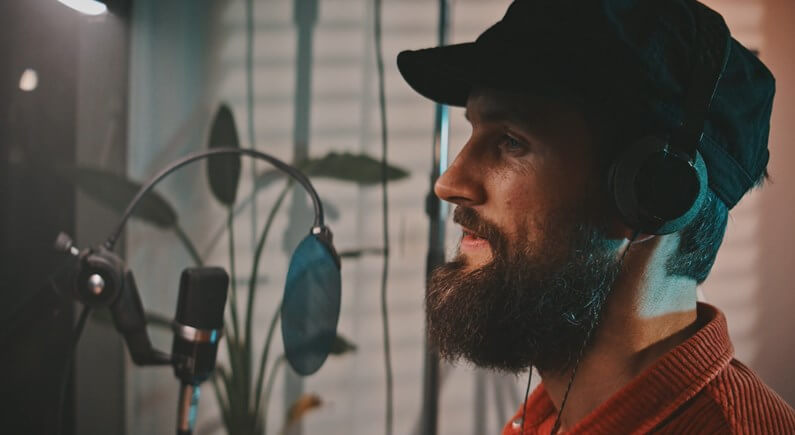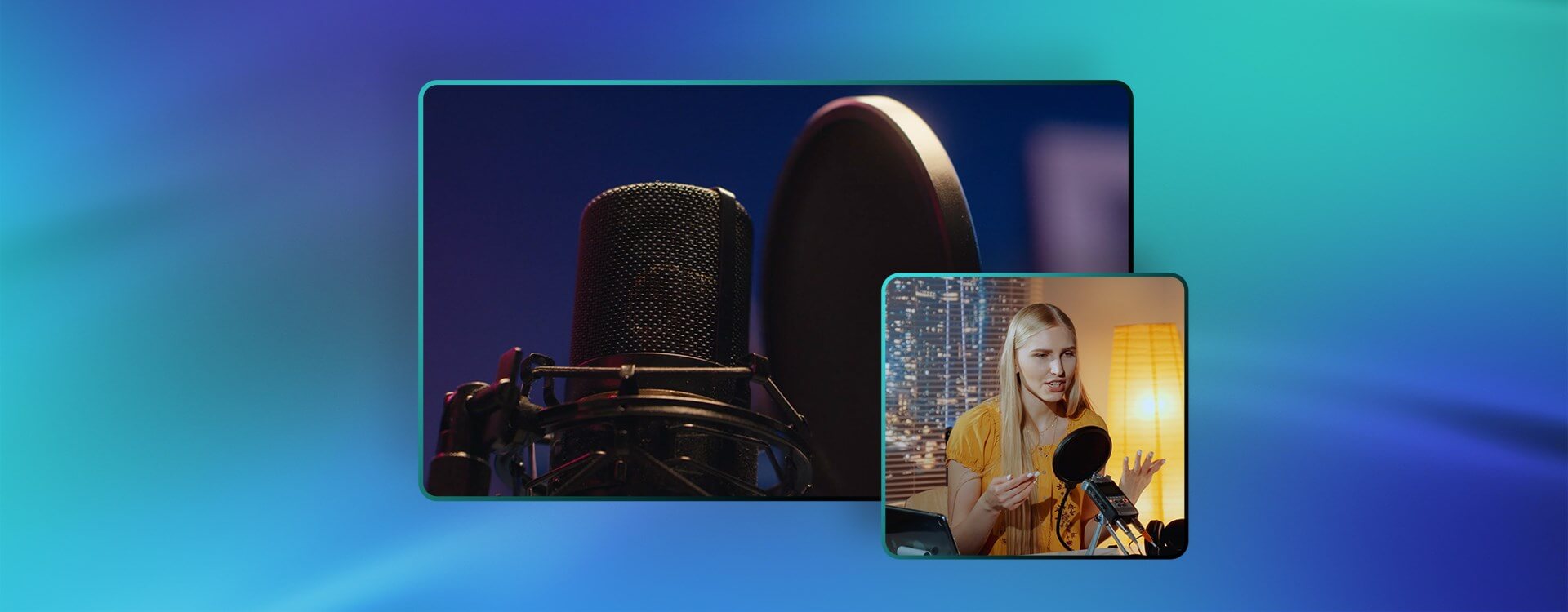Highlights
Table of Contents
Explore article topics
What is dubbing?
Audio dubbing is the process of replacing the original dialogue from your video or film with new audio. Unlike Voiceover, which plays over your videos but is separate from your content, audio dubbing aims to replace the dialogue as precisely and organically as possible.

There are 2 main uses for movie audio dubbing; ADR (Automated Dialogue Replacement) and language dubbing.
Automated Dialogue Replacement
ADR is far from automated, as it can be a painstaking process largely reliant on the skill of your performer. ADR is performed on clips when the onset recorded dialogue is unusable, such as background noise interruptions or location-based issues like shooting at the beach.
ADR might also be used when script changes are required after the filming is complete. You can see this frequently in movies that have replaced swear words to achieve a lower age certificate. With ADR, it is often the case that only small sections of your film or video need dubbing.
Language dubbing
Language dubbing uses the same process as ADR, creating an entirely new version of your film in another language. While ADR needs to be perfectly timed, so the audience isn’t aware of the dub, a foreign language version of your script will never fit exactly.
A considerable advantage of foreign language dubbing is that it allows you to reach a wider audience for your film. Adding subtitles to your video is also a fantastic option for making your project globally accessible, and it is always good to give your viewers a choice.
How to dub a video
Dubbing occurs during the editing stage of production and will require 3 vital things
- Your performer,
- Audio recording equipment
- A preview of the clips needing ADR/foreign language dubbing
The idea of video dubbing is to repeat the performance and dialogue of the scene in a controlled environment and sync it precisely with the recorded footage. The performer is set up with a microphone, usually in a recording booth, and syncs the lines to the recorded video.
In some ways, it is the reverse process to creating a music video, where the performer will lip-sync to a pre-recorded track. With ADR, the video is finished, and the new audio needs to match the lip movements and emotion of the scene.
Once the new audio tracks are created, they are edited into the project in place of the original lines. You’ll also need to consider editing the new audio to fit in the scene and background SFX to cover the dub.
When is dubbing added to a video or film?
While audio dubbing is added to your films during the post-production process, it is something that you should keep in mind during your filming and editing. Consider several things when voice dubbing your projects, depending on what you want to achieve.
Better audio on set
When it comes to ADR, the best solution is not to need it, or at least reduce the amount of ADR required. So, ensure your audio is the very best it can be at the time of recording. While some locations prohibit clean audio, investing in good microphones and a dedicated sound engineer can save you hours in the ADR booth.
Hide the ADR in the edit
If you know that some of your audio might need ADR, you can edit the film in such a way that will hide the voice dubbing. ADR is challenging when matching precise lip movements, especially in close-up front-on shots. Use the editing to hide the dubbing by focusing on a different character or using wide/profile shots.
Re-write/re-edit
When you intend to create foreign language dubs of your project, you need to keep in mind that not all languages translate to the same length. What is said in 5 words in one language could quite easily be an entire sentence in another. While professional dubbing performers will be experienced with recreating dialogue as precisely as possible, you might need to consider re-writing lines or re-editing the video to better fit the chosen language.
Is video dubbing affordable, and should I include it in my videos?
Audio dubbing is a fantastic process for ADR and foreign language uses, but it can be pretty costly. Along with studio/equipment costs, you will need to provide for the performer and editor on the project.
If you want to create ADR for unusable audio, you may not need your performer for very long, but foreign language versions can take a while to complete. Comparatively, subtitles can be added to your project for little cost, and with auto-subtitling apps, it doesn’t take as long.
Get unlimited high-quality music for your videos
The future of audio dubbing
Synthetic film dubbing and AI deep-fake technology are as potentially scary as they are impressive. With the core technology becoming more accessible, it will be used for much more than the biggest Hollywood blockbusters.
Deep-fake technology allows editors to adjust the facial movements of the performers for a better audio dub sync. While the technology is still being developed, there have been some impressive examples of its use. For example, check out Jack Nicholson speaking French.
Synthetic voice dubbing uses AI to replace your voice with another; essentially, it can make you sound like anyone else in the world.
Deep-fake technology isn’t perfect and can often result in a video-game-style mouth movement. It looks great, but the audience is aware something isn’t quite right. However, when mixed with the incredible Synthetic Voice Dubbing technology, you can quite literally make anyone say anything.
With such substantial technological advancements in AI synthetics and deep fake, audio dubbing is set to become more accessible and cost-effective than ever before. However, while audio dubbing your videos is a legitimate use for these technologies, the danger they represent will most likely see them more robustly regulated in the future.
For most projects, it is unlikely you’ll need to use audio dubbing at all. However, if you do need some ADR or want to create a foreign language version of your film, deep-fake and AI synthetics might be a little out of your reach for now. Still, with some gear, performers and a lot of patience, you can have your next project is sounding as good as it looks.
Chris Suffield is a London-based writer, editor, and voice-over artist at Jellyfielder Studios; he also writes entertainment news for Box Office Buz and enjoys making things from stock footage.
Share this article
Did you find this article useful?
Related Posts
- By Robert Hardy
- 5 MIN READ
- By Chris Suffield
- 16 MIN READ
Latest Posts
- 17 Apr
- By Daniela Bowker
- 7 MIN READ
- 15 Apr
- By Rebecca Helfenbaum
- 4 MIN READ
